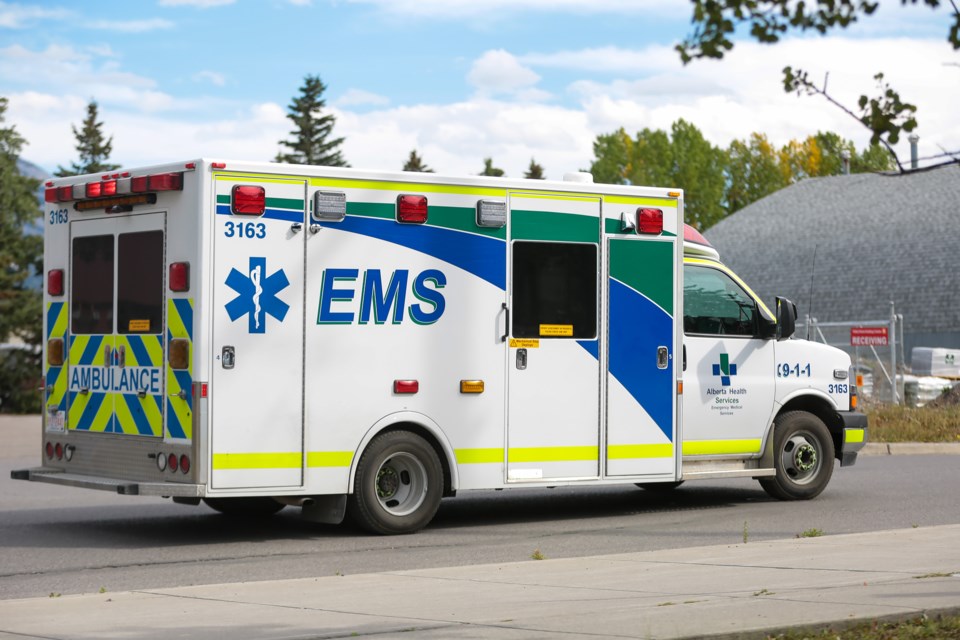BOW VALLEY – The mayors of Banff and Canmore welcome the launch of an advisory committee in the wake of unprecedented strain on Alberta’s ambulance service.
The provincial emergency medical services advisory committee, announced on Jan. 24, is tasked with providing immediate and long-term recommendations to inform a new provincial Emergency Medical Services (EMS) service plan.
In addition, a request for proposals to conduct a third party review of Alberta’s province-wide EMS dispatch system will be issued in February.
In the meantime, Alberta Health Services is immediately rolling out a 10-point plan to quickly add capacity to EMS, including hiring more paramedics.
Banff Mayor Corrie DiManno said measures to address challenges facing Banff residents – and Albertans – in their most desperate time is a worthy effort.
She said the Town of Banff’s own emergency management team will review the immediate actions in the 10-point plan as well as any future recommendations coming out of the advisory committee.
“We are especially glad to see action being taken toward tackling the issue of EMS shortages in some communities at certain times, including the Bow Valley,” said Mayor DiManno.
“We look forward to learning about the solutions for the depleting of rural ambulance resources, which currently occurs when they are dispatched to urban centres.”
Canmore Mayor Sean Krausert also welcomed the news.
“As we’ve seen the strain on the EMS system for some time now, I’m pleased to see that the provincial government has made this a priority,” he said.
“I sincerely hope Alberta Health Services’ plan will add much-needed capacity to EMS as soon as possible in order to serve our community better.”
Province-wide, EMS paramedics and other healthcare professionals are advocating for ambulances designated to serve the communities in which they are stationed to remain there instead of being called away to other locations such as Calgary, potentially for the entire day.
Alberta Health Services’ current province-wide dispatch system for EMS requires the closest ambulance to go on every call, regardless of the priority status of the patient. For example, ambulances are dispatched to Calgary from both the station they are attached to as well as after clearing a city hospital.
Ambulance delays across the province due to the current dispatching system are also putting added pressure and stress on local fire departments, including in Canmore and Banff, which have been tending to patients while waiting for ambulances to arrive.
On Jan. 20, an ambulance from Banff was sent to respond to an emergency event in Calgary. There have been many occasions in the last several months when there have been no ambulances in the Bow Valley.
According to the province, five strategies in the 10-point plan are already underway, including hiring more paramedics, launching pilot projects to manage non-emergency inter-facility transfers, initiating an ‘hours of work’ project to help ease staff fatigue, transferring low priority calls to other agencies in consultation with EMS physicians and stopping the automatic dispatch of ambulances to motor vehicle collisions in which no one is injured.
Other actions to come include an evaluation by an emergency communications officer to determine if an ambulance from out of the area, though it may be closest to a 911 call, is most appropriate to respond, and allowing ambulances to be pre-empted from assignments, instead of being automatically dispatched when a 911 call is received, to ensure more ambulances are available for critical patients – among others.
Over the last several months, EMS has received a 30 per cent increase in 911 calls across the province.
In addition to increased 911 calls, EMS pressures include staffing fatigue and illness, hospital offload delays, more requests for patient transfers, and delays in receiving new ambulances and specialized vehicle parts caused by global supply issues.
The advisory committee will include contracted ambulance operators, unions representing paramedics, municipal representatives and Indigenous community representatives. Members will collaborate, identify concerns, provide advice and inform a new provincial EMS service plan.




